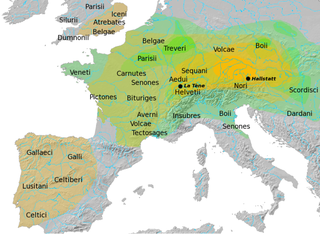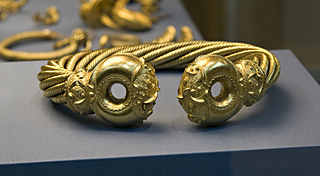Related Research Articles

The La Tène culture was a European Iron Age culture. It developed and flourished during the late Iron Age, succeeding the early Iron Age Hallstatt culture without any definite cultural break, under considerable Mediterranean influence from the Greeks in pre-Roman Gaul, the Etruscans, and the Golasecca culture, but whose artistic style nevertheless did not depend on those Mediterranean influences.

Andrew Colin Renfrew, Baron Renfrew of Kaimsthorn, was a British archaeologist, paleolinguist and Conservative peer noted for his work on radiocarbon dating, the prehistory of languages, archaeogenetics, neuroarchaeology, and the prevention of looting at archaeological sites.

The Hallstatt culture was the predominant Western and Central European archaeological culture of the Late Bronze Age from the 12th to 8th centuries BC and Early Iron Age Europe from the 8th to 6th centuries BC, developing out of the Urnfield culture of the 12th century BC and followed in much of its area by the La Tène culture. It is commonly associated with Proto-Celtic speaking populations.

Stuart Ernest Piggott, was a British archaeologist, best known for his work on prehistoric Wessex.
The modern Celts are a related group of ethnicities who share similar Celtic languages, cultures and artistic histories, and who live in or descend from one of the regions on the western extremities of Europe populated by the Celts.

The Gundestrup cauldron is a richly decorated silver vessel, thought to date from between 200 BC and 300 AD, or more narrowly between 150 BC and 1 BC. This places it within the late La Tène period or early Roman Iron Age. The cauldron is the largest known example of European Iron Age silver work. It was found dismantled, with the other pieces stacked inside the base, in 1891, in a peat bog near the hamlet of Gundestrup in the Aars parish of Himmerland, Denmark. It is now usually on display in the National Museum of Denmark in Copenhagen, with replicas at other museums; it was in the UK on a travelling exhibition called The Celts during 2015–2016.

Situla, from the Latin word for bucket or pail, is the term in archaeology and art history for a variety of elaborate bucket-shaped vessels from the Bronze Age to the Middle Ages, usually with a handle at the top. All types may be highly decorated, most characteristically with reliefs in bands or friezes running round the vessel.

Arthur Dale Trendall, was a New Zealand art historian and classical archaeologist whose work on identifying the work of individual artists on Greek ceramic vessels at Apulia and other sites earned him international prizes and a papal knighthood.

Martin John Millett, is a British archaeologist and academic. From 2001 to 2022, he was the Laurence Professor of Classical Archaeology at the University of Cambridge and a professorial fellow of Fitzwilliam College, Cambridge. Since 2021, he has been the president of the Society of Antiquaries of London.
Miranda Jane Aldhouse-Green, is a British archaeologist and academic, known for her research on the Iron Age and the Celts. She was Professor of Archaeology at Cardiff University from 2006 to 2013. Until about 2000, she published as Miranda Green or Miranda J. Green.
Robert Aldrich is an Australian historian and writer. Aldrich is Professor Emeritus of European History at the University of Sydney, where he taught from 1981-2021. He researches modern European and colonial history, particularly the French and British empires, as well as the history of modern monarchy.

The Wandsworth Shield is a circular bronze Iron Age shield boss or mount decorated in La Tène style which was found in the River Thames at Wandsworth in London sometime before 1849. Another incomplete bronze shield mount, sometimes called the Wandsworth Mask Shield was found at the same time. Both shield mounts are now held at the British Museum. The bold repoussé decoration on the Wandsworth Shield, comprising two birds with outstretched wings and long trailing tail feathers, has led Barry Cunliffe, Emeritus Professor of European Archaeology at the University of Oxford, to consider the shield to be "among the masterpieces of British Celtic art".
William "Bill" Culican was an Australian archaeologist and lecturer in biblical archaeology and pre-classical antiquity at the University of Melbourne.
Nicholas Doumanis is a historian of Europe and the Mediterranean world. Born in Australia in 1964, he studied at the University of Sydney and the University of New South Wales, where he acquired his PhD.

The Mšecké Žehrovice Head is a male sculpted head from c. 150–50 BC found at the double Viereckschanze site in Mšecké Žehrovice, about 65 km northwest of Prague, Czech Republic. It is one of the best known works of Celtic art from Iron Age Europe, and, along with the Glauberg "Prince" and the Warrior of Hirschlanden, one of the few large representations of the human figure. After its discovery in 1943, the sculpture became one of the most photographed, reproduced and published La Tène objects ever.

Prehistoric art in Scotland is visual art created or found within the modern borders of Scotland, before the departure of the Romans from southern and central Britain in the early fifth century CE, which is usually seen as the beginning of the early historic or Medieval era. There is no clear definition of prehistoric art among scholars and objects that may involve creativity often lack a context that would allow them to be understood.

The Great Torc from Snettisham or Snettisham Great Torc is a large Iron Age torc or neck ring in electrum, from the 1st century BC. It is one of the finest pieces of early Celtic art in a distinctly British Celtic style. It is the most spectacular object in the Snettisham Hoard of torcs and other metalwork found in 1950 near the village of Snettisham in Norfolk, East Anglia. The perfectly intact torc is noted for its high level of craftsmanship and artistry. Soon after its discovery it was acquired by the British Museum.
Sally M. Foster is a Scottish archaeologist and senior lecturer at the University of Stirling. She specialises in the archaeology of Scotland, particularly the Picts and their neighbours in the early medieval period.
Dennis William Harding,, known as D. W. Harding, is a British archaeologist and academic, specialising in the British Iron Age. Having taught at the University of Durham from 1966 to 1977, he was then Abercromby Professor of Archaeology at the University of Edinburgh from 1977 to 2007.

The Celtic leaf-crown is a motif of Celtic art from the early La Tène period. A leaf-crown is composed of two broad lobe-shaped elements. The crowns adorn the heads of anthropomorphic figures, almost always male and often bearded. The lobes have been identified with mistletoe leaves. The interpretation of this motif is doubtful, but it has been suggested to bear connotations of high status or divinity.
References
- 1 2 The Flying Dutchman reaches port Vincent Megaw Antiquity 86 (2012): 546–557
- ↑ Encyclopedia of Global Archaeology - Megaw, Vincent, Springer Science+Business Media, pp 4769-4772, 2014, doi : 10.1007/978-1-4419-0465-2_2392, Subscription required for full article
- ↑ Encyclopedia of Australian Science 2010
- ↑ "J V S Megaw | Flinders University of South Australia - Academia.edu". flinders.academia.edu. Retrieved 11 January 2022.
- ↑ Ruth Megaw obituary by Vincent Megaw, The Guardian Wednesday 31 July 2013
- ↑ The Academy Fellows Australian Academy of the Humanities